Microwave-Assisted Functionalization of Multi-Walled Carbon Nanotubes for Biosensor and Drug Delivery Applications
Abstract
1. Introduction
1.1. Principle of Microwave Synthesis
1.2. Microwave Absorption System
1.3. Applications of the Microwave-Assisted Synthesis
1.4. Carbon Nanotubes (CNTs)
2. Microwave Irradiation-Based Development of MWCNTs
2.1. The Carboxylation of MWCNTs Using Single-Step Microwave Irradiation Technology (MIT)
2.2. Functionalization of MWCNTs with Various Bioactive Molecules Using MIT
2.2.1. Amino Acids and Amino Groups
2.2.2. Vitamins
2.2.3. Proteins
2.2.4. Epoxy
2.3. Covalent and Non-Covalent Modified MWCNTs Nanoparticles by MIT
2.4. Graphene and Other Polymers Used for the Decoration of MWCNTs
2.5. Miscellaneous Chemical Molecules Used to Modify MWCNTs
2.6. MWCNTs for Drug Delivery
2.7. MWCNTs for Biosensor Applications
3. Conclusions
Author Contributions
Funding
Institutional Review Board Statement
Informed Consent Statement
Data Availability Statement
Acknowledgments
Conflicts of Interest
References
- Gawande, M.B.; Shelke, S.N.; Zboril, R.; Varma, R.S. Microwave-Assisted Chemistry: Synthetic Applications for Rapid Assembly of Nanomaterials and Organics. Acc. Chem. Res. 2014, 47, 1338–1348. [Google Scholar] [CrossRef]
- Rauter, A.P.; Christensen, B.; Somsak, L.; Adamo, R.; Kosma, P. Recent Trends in Carbohydrate Chemistry. In Biomedical and Material Science Applications; Elsevier: Amsterdam, The Netherlands, 2020. [Google Scholar]
- Kappe, C.O.; Dallinger, D. The impact of microwave synthesis on drug discovery. Nat. Rev. Drug Discov. 2006, 5, 51–63. [Google Scholar] [CrossRef] [PubMed]
- Santagada, V.; Perissutti, E.; Caliendo, G. The application of microwave irradiation as new convenient synthetic procedure in drug discovery. Curr. Med. Chem. 2002, 9, 1251–1283. [Google Scholar] [CrossRef] [PubMed]
- Gupta, D.; Jamwal, D.; Rana, D.; Katoch, A. Microwave synthesized nanocomposites for enhancing oral bioavailability of drugs. In Applications of Nanocomposite Materials in Drug Delivery; Woodhead Publishing: Duxford, UK, 2018; pp. 619–632. [Google Scholar]
- Mutyala, S.; Fairbridge, C.; ParÈ, J.R.J.; BÈlanger, J.M.R.; Ng, S.H.; Hawkins, R.W. Microwave applications to oil sands and petroleum: A review. Fuel Process. Technol. 2010, 91, 127–135. [Google Scholar] [CrossRef]
- Mishra, A.; Vats, T.; James, H. Chapter 1 Microwave Radiations: Theory and Instrumentation. In Microwave-Assisted Polymerization; The Royal Society of Chemistry: London, UK, 2016; pp. 1–18. [Google Scholar]
- Gaba, M.; Dhingra, N. Microwave Chemistry: General Features and Applications. J. Pharm. Res. 2011, 45, 175–183. [Google Scholar]
- Wang, Y.; Du, Y.; Xu, P.; Qiang, R.; Han, X. Recent Advances in Conjugated Polymer-Based Microwave Absorbing Materials. Polymers 2017, 9, 29. [Google Scholar] [CrossRef]
- Zamorano Ulloa, R.; Guadalupe Hernandez Santiago, M.; L. Villegas Rueda, V. The Interaction of Microwaves with Materials of Different Properties. In Electromagnetic Fields and Waves; IntechOpen: London, UK, 2019. [Google Scholar]
- Wathey, B.; Tierney, J.; Lidström, P.; Westman, J. The impact of microwave-assisted organic chemistry on drug discovery. Drug Discov. Today 2002, 7, 373–380. [Google Scholar] [CrossRef]
- Folgueras, L.; Alves, M.; Rezende, M. Dielectric Properties of Microwave Absorbing Sheets Produced with Silicone and Polyaniline. Mater. Res. Ibero-Am. J. Mater. 2010, 13, 197–201. [Google Scholar] [CrossRef]
- Meng, F.; Wang, H.; Huang, F.; Guo, Y.; Wang, Z.; Hui, D.; Zhou, Z. Graphene-based microwave absorbing composites: A review and prospective. Compos. Part B Eng. 2018, 137, 260–277. [Google Scholar] [CrossRef]
- Stadler, A.; Yousefi, B.H.; Dallinger, D.; Walla, P.; Van der Eycken, E.; Kaval, N.; Kappe, C.O. Scalability of Microwave-Assisted Organic Synthesis. From Single-Mode to Multimode Parallel Batch Reactors. Org. Process Res. Dev. 2003, 7, 707–716. [Google Scholar] [CrossRef]
- Santagada, V.; Frecentese, F.; Perissutti, E.; Fiorino, F.; Severino, B.; Caliendo, G. Microwave assisted synthesis: A new technology in drug discovery. Mini Rev. Med. Chem. 2009, 9, 340–358. [Google Scholar] [CrossRef]
- De Menezes, B.R.C.; Rodrigues, K.F.; Fonseca, B.C.d.S.; Ribas, R.G.; Montanheiro, T.L.d.A.; Thim, G.P. Recent advances in the use of carbon nanotubes as smart biomaterials. J. Mater. Chem. B 2019, 7, 1343–1360. [Google Scholar] [CrossRef]
- Patra, J.K.; Das, G.; Fraceto, L.; Campos, E.; Rodríguez-Torres, M.D.P.; Acosta-Torres, L.; Diaz-Torres, L.; Grillo, R.; Swamy, M.; Sharma, S.; et al. Nano based drug delivery systems: Recent developments and future prospects. J. Nanobiotechnol. 2018, 16, 1–33. [Google Scholar] [CrossRef]
- Karimi, M.; Solati, N.; Amiri, M.; Mirshekari, H.; Mohamed, E.; Taheri, M.; Hashemkhani, M.; Saeidi, A.; Estiar, M.A.; Kiani, P.; et al. Carbon nanotubes part I: Preparation of a novel and versatile drug-delivery vehicle. Expert. Opin. Drug Deliv. 2015, 12, 1071–1087. [Google Scholar] [CrossRef]
- Anzar, N.; Hasan, R.; Tyagi, M.; Yadav, N.; Narang, J. Carbon nanotube—A review on Synthesis, Properties and plethora of applications in the field of biomedical science. Sens. Int. 2020, 1, 100003. [Google Scholar] [CrossRef]
- Saliev, T. The Advances in Biomedical Applications of Carbon Nanotubes. J. Carbon Res. 2019, 5, 29. [Google Scholar] [CrossRef]
- Rastogi, V.; Yadav, P.; Bhattacharya, S.S.; Mishra, A.K.; Verma, N.; Verma, A.; Pandit, J.K. Carbon nanotubes: An emerging drug carrier for targeting cancer cells. J. Drug Deliv. 2014, 2014, 670815. [Google Scholar] [CrossRef]
- Mousa, M.S. Comparison between Single-Walled CNT, Multi-Walled CNT, and Carbon Nanotube-Fiber Pyrograf III. In Materials Science and Engineering Conference Series; IOP Publishing Ltd.: Irbid, Jordan, 2017; p. 012025. [Google Scholar]
- Mehra, N.; And, K.; Jain, N. Functionalized Carbon Nanotubes and Their Drug Delivery Applications; Bhoop, B.S., Ed.; Studium Press, LLC: London, UK, 2014; Volume 4, pp. 327–329. [Google Scholar]
- Jampilek, J.; Kralova, K. Advances in Drug Delivery Nanosystems Using Graphene-Based Materials and Carbon Nanotubes. Materials 2021, 14, 1059. [Google Scholar] [CrossRef]
- Jackson, P.; Jacobsen, N.R.; Baun, A.; Birkedal, R.; Kühnel, D.; Jensen, K.A.; Vogel, U.; Wallin, H. Bioaccumulation and ecotoxicity of carbon nanotubes. Chem. Cent. J. 2013, 7, 154. [Google Scholar] [CrossRef]
- Fahrenholtz, C.D.; Hadimani, M.; King, S.B.; Torti, S.V.; Singh, R. Targeting breast cancer with sugar-coated carbon nanotubes. Nanomedicine 2015, 10, 2481–2497. [Google Scholar] [CrossRef] [PubMed]
- Zhou, Y.; Fang, Y.; Ramasamy, R.P. Non-Covalent Functionalization of Carbon Nanotubes for Electrochemical Biosensor Development. Sensors 2019, 19, 392. [Google Scholar] [CrossRef] [PubMed]
- Jain, S.; Thakare, V.S.; Das, M.; Godugu, C.; Jain, A.K.; Mathur, R.; Chuttani, K.; Mishra, A.K. Toxicity of multiwalled carbon nanotubes with end defects critically depends on their functionalization density. Chem. Res. Toxicol. 2011, 24, 2028–2039. [Google Scholar] [CrossRef] [PubMed]
- Goyanes, S.; Rubiolo, G.; Salazar, A.; Jimeno, A.; Corcuera, M.; Mondragon, I. Carboxylation treatment of multiwalled carbon nanotubes monitored by infrared and ultraviolet spectroscopies and scanning probe microscopy. Diam. Relat. Mater. 2007, 16, 412–417. [Google Scholar] [CrossRef]
- Patel, K.D.; Singh, R.K.; Kim, H.-W. Carbon-based nanomaterials as an emerging platform for theranostics. Mater. Horiz. 2019, 6, 434–469. [Google Scholar] [CrossRef]
- Gude, V.G.; Patil, P.; Deng, S. Microwave energy potential for large scale biodiesel production. In Proceedings of the World Renewable Energy Forum, WREF 2012, Including World Renewable Energy Congress XII and Colorado Renewable Energy Society (CRES) Annual Conference, Denver, CO, USA, 13–17 May 2012; pp. 751–759. [Google Scholar]
- Yang, S.; Wang, Z.; Ping, Y.; Miao, Y.; Xiao, Y.; Qu, L.; Zhang, L.; Hu, Y.; Wang, J. PEG/PEI-functionalized single-walled carbon nanotubes as delivery carriers for doxorubicin: Synthesis, characterization, and in vitro evaluation. Beilstein. J. Nanotechnol. 2020, 11, 1728–1741. [Google Scholar] [CrossRef]
- Das, S.S.; Bharadwaj, P.; Bilal, M.; Barani, M.; Rahdar, A.; Taboada, P.; Bungau, S.; Kyzas, G.Z. Stimuli-Responsive Polymeric Nanocarriers for Drug Delivery, Imaging, and Theragnosis. Polymers 2020, 12, 1397. [Google Scholar] [CrossRef]
- Skúlason, E.; Bligaard, T.; Gudmundsdóttir, S.; Studt, F.; Rossmeisl, J.; Abild-Pedersen, F.; Vegge, T.; Jonsson, H.; Nørskov, J. A theoretical evaluation of possible transition metal electro-catalysts for N-2 reduction. Phys. Chem. Chem. Phys. PCCP 2011, 14, 1235–1245. [Google Scholar] [CrossRef]
- Simon, J.; Flahaut, E.; Golzio, M. Overview of Carbon Nanotubes for Biomedical Applications. Materials 2019, 12, 624. [Google Scholar] [CrossRef]
- Cano, M.; Benito, A.; Maser, W.K.; Urriolabeitia, E.P. One-step microwave synthesis of palladium–carbon nanotube hybrids with improved catalytic performance. Carbon 2011, 49, 652–658. [Google Scholar] [CrossRef]
- Pacheco, F.G.; Cotta, A.A.C.; Gorgulho, H.F.; Santos, A.P.; Macedo, W.A.A.; Furtado, C.A. Comparative temporal analysis of multiwalled carbon nanotube oxidation reactions: Evaluating chemical modifications on true nanotube surface. Appl. Surf. Sci. 2015, 357, 1015–1023. [Google Scholar] [CrossRef]
- Pelalak, R.; Heidari, Z. Lithographically Cut Multiwalled Carbon Nanotubes: Opening Caps, Controlling Length Distribution, and Functionalization. J. Dispers. Sci. Technol. 2014, 35, 808–814. [Google Scholar] [CrossRef]
- Karimifard, S.; Moghaddam, M.R.A. Enhancing the adsorption performance of carbon nanotubes with a multistep functionalization method: Optimization of Reactive Blue 19 removal through response surface methodology. Process Saf. Environ. Prot. 2016, 99, 20–29. [Google Scholar] [CrossRef]
- Hojati-Talemi, P.; Simon, G. Microwave-based treatments for multi-walled carbon nanotubes. Phys. Status Solidi C 2009, 6, 2170–2173. [Google Scholar] [CrossRef]
- Mostovoy, A.; Yakovlev, A.; Tseluikin, V.; Lopukhova, M. Epoxy nanocomposites reinforced with functionalized carbon nanotubes. Polymers 2020, 12, 1816. [Google Scholar] [CrossRef]
- Mallakpour, S.; Soltanian, S. Morphology and thermal properties of nanocomposites based on chiral poly (ester-imide) matrix reinforced by vitamin B1 functionalized multiwalled carbon nanotubes. J. Compos. Mater. 2017, 51, 2291–2300. [Google Scholar] [CrossRef]
- Amiri, A.; Shanbedi, M.; Savari, M.; Chew, B.; Kazi, S. Cadmium ion sorption from aqueous solutions by high surface area ethylenediaminetetraacetic acid-and diethylene triamine pentaacetic acid-treated carbon nanotubes. RSC Adv. 2015, 5, 71144–71152. [Google Scholar] [CrossRef]
- Amiri, A.; Kazi, S.N.; Shanbedi, M.; Mohd Zubir, M.N.; Yarmand, H.; Chew, B.T. Transformer oil based multi-walled carbon nanotube–hexylamine coolant with optimized electrical, thermal and rheological enhancements. RSC Adv. 2015, 5, 107222–107236. [Google Scholar] [CrossRef]
- Amiri, A.; Sadri, R.; Ahmadi, G.; Chew, B.; Kazi, S.; Shanbedi, M.; Alehashem, M.S. Synthesis of polyethylene glycol-functionalized multi-walled carbon nanotubes with a microwave-assisted approach for improved heat dissipation. RSC Adv. 2015, 5, 35425–35434. [Google Scholar] [CrossRef]
- Amiri, A.; Maghrebi, M.; Baniadam, M.; Heris, S.Z. One-pot, efficient functionalization of multi-walled carbon nanotubes with diamines by microwave method. Appl. Surf. Sci. 2011, 257, 10261–10266. [Google Scholar] [CrossRef]
- Ghiadi, B.; Baniadam, M.; Maghrebi, M.; Amiri, A. Rapid, one-pot synthesis of highly-soluble carbon nanotubes functionalized by L-arginine. Russ. J. Phys. Chem. A 2013, 87, 649–653. [Google Scholar] [CrossRef]
- Amiri, A.; Zardini, H.Z.; Shanbedi, M.; Maghrebi, M.; Baniadam, M.; Tolueinia, B. Efficient method for functionalization of carbon nanotubes by lysine and improved antimicrobial activity and water-dispersion. Mater. Lett. 2012, 72, 153–156. [Google Scholar] [CrossRef]
- Zomorodbakhsh, S.; Mirza, B.; Yazdizadeh, S.; Tavahodi, E. Short time Modification of Carboxylated Multi-wall Nanotubes with Amino Uracil Derivative. Orient. J. Chem. 2014, 30, 1379–1383. [Google Scholar]
- Zardini, H.Z.; Amiri, A.; Shanbedi, M.; Maghrebi, M.; Baniadam, M. Enhanced antibacterial activity of amino acids-functionalized multi walled carbon nanotubes by a simple method. Colloids Surf. B Biointerfaces 2012, 92, 196–202. [Google Scholar] [CrossRef] [PubMed]
- Abdolmaleki, A.; Mallakpour, S.; Azimi, F. Microwave and ultrasound-assisted synthesis of poly (vinyl chloride)/riboflavin modified MWCNTs: Examination of thermal, mechanical and morphology properties. Ultrason. Sonochem. 2018, 41, 27–36. [Google Scholar] [CrossRef] [PubMed]
- Mallakpour, S.; Soltanian, S. A facile approach towards functionalization of MWCNTs with vitamin B2 for reinforcing of biodegradable and chiral poly (ester-imide) having L-phenylalanine linkages: Morphological and thermal investigations. J. Polym. Res. 2015, 22, 1–9. [Google Scholar] [CrossRef]
- Mallakpour, S.; Soltanian, S. Environmentally friendly functionalization of multiwalled carbon nanotube using ascorbic acid and efficient dispersion in chiral poly (ester-imide) containing 4, 4′-thiobis (2-tert-butyl-5-methylphenol) moiety: Thermal and morphological studies. Colloid Polym. Sci. 2015, 293, 1141–1149. [Google Scholar] [CrossRef]
- Mallakpour, S.; Zadehnazari, A. Microwave-induced chemical functionalization of carboxylated multi-walled nanotubes with p-aminophenol: Towards the synthesis of MWCNT–poly (amide-imide) hybrids. Polym. Sci. Ser. B 2015, 57, 717–729. [Google Scholar] [CrossRef]
- Mallakpour, S.; Soltanian, S. Microwave assisted functionalization of carboxylated-multiwalled carbon nanotubes with 5-aminoisophthalic acid and its application for the preparation of chiral poly (ester-imide)/CNT nanocomposites. Polym. Compos. 2016, 37, 835–843. [Google Scholar] [CrossRef]
- Mallakpour, S.; Zadehnazari, A. The production of functionalized multiwall carbon nanotube/amino acid-based poly (amide–imide) composites containing a pendant dopamine moiety. Carbon 2013, 56, 27–37. [Google Scholar] [CrossRef]
- Mallakpour, S.; Zadehnazari, A. Functionalization of multiwalled carbon nanotubes with S-valine amino acid and its reinforcement on amino acid-containing poly (amide-imide) bionanocomposites. High Perform. Polym. 2013, 25, 966–979. [Google Scholar] [CrossRef]
- Puentes-Camacho, D.; Velázquez, E.F.; Rodríguez-Félix, D.E.; Castillo-Ortega, M.; Sotelo-Mundo, R.R.; del Castillo-Castro, T. Functionalization of multiwalled carbon nanotubes by microwave irradiation for lysozyme attachment: Comparison of covalent and adsorption methods by kinetics of thermal inactivation. Adv. Nat. Sci. Nanosci. Nanotechnol. 2017, 8, 045011. [Google Scholar] [CrossRef]
- Moaseri, E.; Bazubandi, B.; Karimi, M.; Maghrebi, M.; Baniadam, M. Mechanical improvements of multi-walled carbon nanotube-epoxy composite: Covalent functionalization of multi-walled carbon nanotube by epoxy chains. Polym. Sci. Ser. B 2019, 61, 341–348. [Google Scholar] [CrossRef]
- Moaseri, E.; Hasanabadi, S.; Maghrebi, M.; Baniadam, M. Improvements in fatigue life of amine-functionalized multi-walled carbon nanotube-reinforced epoxy composites: Effect of functionalization degree and microwave-assisted precuring. J. Compos. Mater. 2015, 49, 1961–1969. [Google Scholar] [CrossRef]
- Obliosca, J.M.; Wu, Y.-S.; Hsieh, H.-Y.; Chang, C.-J.; Wang, P.-C.; Tseng, F.-G. Synthesis and optical properties of gold/silver nanocomposites prepared on multi-walled carbon nanotubes via galvanic replacement of silver nanoparticles. J. Nanopart. Res. 2012, 14, 1–8. [Google Scholar] [CrossRef]
- Martinez-Elena, A.; Lopez-Carrillo, M.; Rueda-Morales, G.; Ortega-Cervantez, G.; Moreno-Ruiz, L.; Ortiz-Lopez, J. PVA membranes with a surface layer of magnetically-patterned cobalt-containing multiwall carbon nanotubes. J. Mater. Sci. Mater. Electron. 2020, 31, 1604–1615. [Google Scholar] [CrossRef]
- Rudd, J.A.; Gowenlock, C.E.; Gomez, V.; Kazimierska, E.; Al-Enizi, A.M.; Andreoli, E.; Barron, A.R. Solvent-free microwave-assisted synthesis of tenorite nanoparticle-decorated multi-walled carbon nanotubes. J. Mater. Sci. Technol. 2019, 35, 1121–1127. [Google Scholar] [CrossRef]
- Rigo, C.; Severo, E.d.C.; Mazutti, M.A.; Dotto, G.L.; Jahn, S.L.; Gündel, A.; Lucchese, M.M.; Chiavone-Filho, O.; Foletto, E.L. Preparation of nickel ferrite/carbon nanotubes composite by microwave irradiation technique for use as catalyst in photo-fenton reaction. Mater. Res. 2017, 20, 311–316. [Google Scholar] [CrossRef]
- Sherrell, P.C.; Chen, J.; Razal, J.M.; Nevirkovets, I.P.; Crean, C.; Wallace, G.G.; Minett, A.I. Advanced microwave-assisted production of hybrid electrodes for energy applications. Energy Environ. Sci. 2010, 3, 1979–1984. [Google Scholar] [CrossRef]
- Jiang, S.; Wang, S.; Wang, X. Development of PtRu Electrocatalysts on 1-Aminopyrene Functionalized MWCNTs for Direct Methanol Fuel Cells. ECS Trans. 2008, 16, 467. [Google Scholar] [CrossRef]
- Poh, C.K.; Lim, S.H.; Pan, H.; Lin, J.; Lee, J.Y. Citric acid functionalized carbon materials for fuel cell applications. J. Power Sources 2008, 176, 70–75. [Google Scholar] [CrossRef]
- Raghuveer, M.S.; Agrawal, S.; Bishop, N.; Ramanath, G. Microwave-assisted single-step functionalization and in situ derivatization of carbon nanotubes with gold nanoparticles. Chem. Mater. 2006, 18, 1390–1393. [Google Scholar] [CrossRef]
- Shibin, Y.; Qiangqiang, Z.; QIANG, Y.; Lin, L. Functionalized carbon nanotubes as Pt catalyst supports in methanol oxidation. Chin. J. Catal. 2012, 33, 290–297. [Google Scholar]
- Yin, S.; Luo, L.; Xu, C.; Zhao, Y.; Qiang, Y.; Mu, S. Functionalizing carbon nanotubes for effective electrocatalysts supports by an intermittent microwave heating method. J. Power Sources 2012, 198, 1–6. [Google Scholar] [CrossRef]
- Nassr, A.B.A.A.; Kottakkat, T.; Bron, M. A simple microwave process for the preparation of cobalt oxide nanoparticles supported on carbon nanotubes for electrocatalytic applications. J. Solid State Electrochem. 2020, 24, 131–136. [Google Scholar] [CrossRef]
- Tamilarasan, P.; Ramaprabhu, S. A polymerized ionic liquid functionalized cathode catalyst support for a proton exchange membrane CO 2 conversion cell. RSC Adv. 2015, 5, 24864–24871. [Google Scholar] [CrossRef]
- Mezalira, D.Z.; Bron, M. High stability of low Pt loading high surface area electrocatalysts supported on functionalized carbon nanotubes. J. Power Sources 2013, 231, 113–121. [Google Scholar] [CrossRef]
- Maron, G.; Noremberg, B.; Alano, J.; Pereira, F.; Deon, V.; Santos, R.; Freire, V.; Valentini, A.; Carreno, N.L.V. Carbon fiber/epoxy composites: Effect of zinc sulphide coated carbon nanotube on thermal and mechanical properties. Polym. Bull. 2018, 75, 1619–1633. [Google Scholar] [CrossRef]
- Shariatzadeh, B.; Moradi, O. Surface functionalization of multiwalled carbon nanotubes with chitosan and magnesium oxide nanoparticles by microwave-assisted synthesis. Polym. Compos. 2014, 35, 2050–2055. [Google Scholar] [CrossRef]
- Stamatin, S.N.; Borghei, M.; Andersen, S.M.; Veltze, S.; Ruiz, V.; Kauppinen, E.; Skou, E.M. Influence of different carbon nanostructures on the electrocatalytic activity and stability of Pt supported electrocatalysts. Int. J. Hydrogen Energy 2014, 39, 8215–8224. [Google Scholar] [CrossRef]
- Variava, M.F.; Church, T.L.; Harris, A.T. Magnetically recoverable FexOy–MWNT Fenton’s catalysts that show enhanced activity at neutral pH. Appl. Catal. B Environ. 2012, 123, 200–207. [Google Scholar] [CrossRef]
- Wang, S.; Wang, X.; Jiang, S.P. PtRu nanoparticles supported on 1-aminopyrene-functionalized multiwalled carbon nanotubes and their electrocatalytic activity for methanol oxidation. Langmuir 2008, 24, 10505–10512. [Google Scholar] [CrossRef] [PubMed]
- Yañez-Macias, R.; Hernandez-Hernandez, E.; Gallardo-Vega, C.A.; Ledezma-Rodríguez, R.; Ziolo, R.F.; Mendoza-Tolentino, Y.; Fernández-Tavizon, S.; Avila-Orta, C.A.; Garcia-Hernandez, Z.; Gonzalez-Morones, P. Covalent grafting of unfunctionalized pristine MWCNT with Nylon-6 by microwave assist in-situ polymerization. Polymer 2019, 185, 121946. [Google Scholar] [CrossRef]
- Veloz-Castillo, M.F.; Paredes-Arroyo, A.; Vallejo-Espinosa, G.; Delgado-Jiménez, J.F.; Coffer, J.L.; González-Rodríguez, R.; Mendoza, M.E.; Campos-Delgado, J.; Méndez-Rojas, M.A. Carbon nanotubes and carbon fibers in a flash: An easy and convenient preparation of carbon nanostructures using a conventional microwave. Can. J. Chem. 2020, 98, 49–55. [Google Scholar] [CrossRef]
- Ortega-Cervantez, G.; Gómez-Aguilar, R.; Rueda-Morales, G.; Ortiz-Lopez, J. Microwave-assisted synthesis of sponge-like carbon nanotube arrays and their application in organic transistor devices. J. Mater. Sci. Mater. Electron. 2016, 27, 12642–12648. [Google Scholar] [CrossRef]
- Karami, H.; Papari-Zare, S.; Shanbedi, M.; Eshghi, H.; Dashtbozorg, A.; Akbari, A.; Mohammadian, E.; Heidari, M.; Sahin, A.Z.; Teng, C.B. The thermophysical properties and the stability of nanofluids containing carboxyl-functionalized graphene nano-platelets and multi-walled carbon nanotubes. Int. Commun. Heat Mass Transf. 2019, 108, 104302. [Google Scholar] [CrossRef]
- Kumar, R.; Singh, R.K.; Tiwari, V.S.; Yadav, A.; Savu, R.; Vaz, A.R.; Moshkalev, S.A. Enhanced magnetic performance of iron oxide nanoparticles anchored pristine/N-doped multi-walled carbon nanotubes by microwave-assisted approach. J. Alloys Compd. 2017, 695, 1793–1801. [Google Scholar] [CrossRef]
- Azizian, J.; Tahermansouri, H.; Chobfrosh Khoei, D.; Yadollahzadeh, K.; Delbari, A.S. Microwave-induced chemical functionalization of carboxylated multi-walled nanotubes with 2, 3-diaminopyridine. Fuller. Nanotub. Carbon Nanostruct. 2012, 20, 183–190. [Google Scholar] [CrossRef]
- Tahermansouri, H.; Chobfrosh Khoei, D.; Meskinfam, M. The chemical functionalization of carboxylated multi-wall nanotubes with 2-aminophenole via microwave irradiation. Orient. J. Chem. 2011, 27, 499. [Google Scholar]
- Mahmoodian, H.; Moradi, O.; Shariatzadeh, B. Grafting chitosan and polyHEMA on carbon nanotubes surfaces:“Grafting to” and “Grafting from” methods. Int. J. Biol. Macromol. 2014, 63, 92–97. [Google Scholar] [CrossRef]
- Tahermansouri, H.; Abedi, E. One-pot functionalization of short carboxyl multi-walled carbon nanotubes with ninhydrin and thiourea via microwave and thermal methods and their effect on MKN-45 and MCF7 cancer cells. Fuller. Nanotub. Carbon Nanostruct. 2014, 22, 834–844. [Google Scholar] [CrossRef]
- Davarpanah, M.; Maghrebi, M.; Hosseinipour, E. Microwave-induced high surface functionalization of multi-walled carbon nanotubes for long-term dispersion in water. Appl. Phys. A 2014, 115, 167–175. [Google Scholar] [CrossRef]
- Zardini, H.Z.; Davarpanah, M.; Shanbedi, M.; Amiri, A.; Maghrebi, M.; Ebrahimi, L. Microbial toxicity of ethanolamines—Multiwalled carbon nanotubes. J. Biomed. Mater. Res. Part A 2014, 102, 1774–1781. [Google Scholar] [CrossRef]
- Tahermansouri, H.; Ghobadinejad, H. Functionalization of short multi-walled carbon nanotubes with creatinine and aromatic aldehydes via microwave and thermal methods and their influence on the MKN45 and MCF7 cancer cells. C. R. Chim. 2013, 16, 838–844. [Google Scholar] [CrossRef]
- Bonalume, B.; Lebrão, G.; Rossi, J. Microwave assist functionalization of multi walled carbon nanotubes. In Proceedings of the 15th European Conference On Composite Materials, Venice, Italy, 24–28 June 2012; pp. 1–8. [Google Scholar]
- Zomorodbakhsh, S.; Tavahodi, E.; Torabi, P. Microwave-Assisted Functionalization of Carboxylated Multi-walled Carbon Nanotubes with Isatin Derivatives. Fuller. Nanotub. Carbon Nanostruct. 2015, 23, 332–338. [Google Scholar] [CrossRef]
- Huang, S.; Liu, T.; Zhang, W.D.; Tjiu, W.C.; He, C.; Lu, X. Grafting polyamide 6 onto multi-walled carbon nanotubes using microwave irradiation. Polym. Int. 2010, 59, 1346–1349. [Google Scholar] [CrossRef]
- Zare, H.; Ahmadi, S.; Ghasemi, A.; Ghanbari, M.; Rabiee, N.; Bagherzadeh, M.; Karimi, M.; Webster, T.J.; Hamblin, M.R.; Mostafavi, E. Carbon Nanotubes: Smart Drug/Gene Delivery Carriers. Int J Nanomed. 2021, 16, 1681–1706. [Google Scholar] [CrossRef]
- García-Hevia, L.; Villegas, J.C.; Fernández, F.; Casafont, Í.; González, J.; Valiente, R.; Fanarraga, M.L. Multiwalled Carbon Nanotubes Inhibit Tumor Progression in a Mouse Model. Adv. Heal. Mater. 2016, 5, 1080–1087. [Google Scholar] [CrossRef]
- Li, B.; Zhang, X.X.; Huang, H.Y.; Chen, L.Q.; Cui, J.H.; Liu, Y.; Jin, H.; Lee, B.J.; Cao, Q.R. Effective deactivation of A549 tumor cells in vitro and in vivo by RGD-decorated chitosan-functionalized single-walled carbon nanotube loading docetaxel. Int. J. Pharm. 2018, 543, 8–20. [Google Scholar] [CrossRef]
- Kim, S.W.; Kyung Lee, Y.; Yeon Lee, J.; Hee Hong, J.; Khang, D. PEGylated anticancer-carbon nanotubes complex targeting mitochondria of lung cancer cells. Nanotechnology 2017, 28, 465102. [Google Scholar] [CrossRef]
- Koh, B.; Park, S.B.; Yoon, E.; Yoo, H.M.; Lee, D.; Heo, J.N.; Ahn, S. α(V)β(3)-Targeted Delivery of Camptothecin-Encapsulated Carbon Nanotube-Cyclic RGD in 2D and 3D Cancer Cell Culture. J. Pharm. Sci. 2019, 108, 3704–3712. [Google Scholar] [CrossRef] [PubMed]
- Liu, X.; Xu, D.; Liao, C.; Fang, Y.; Guo, B. Development of a promising drug delivery for formononetin: Cyclodextrin-modified single-walled carbon nanotubes. J. Drug Deliv. Sci. Technol. 2018, 43, 461–468. [Google Scholar] [CrossRef]
- Harsha, P.; Thotakura, N.; Kumar, M.; Sharma, S.; Mittal, A.; Khurana, R.K.; Singh, B.; Negi, P.; Raza, K. A novel PEGylated carbon nanotube conjugated mangiferin: An explorative nanomedicine for brain cancer cells. J. Drug Deliv. Sci. Technol. 2019, 53, 101186. [Google Scholar] [CrossRef]
- Raza, K.; Kumar, D.; Kiran, C.; Kumar, M.; Guru, S.K.; Kumar, P.; Arora, S.; Sharma, G.; Bhushan, S.; Katare, O. Conjugation of docetaxel with multiwalled carbon nanotubes and codelivery with piperine: Implications on pharmacokinetic profile and anticancer activity. Mol. Pharm. 2016, 13, 2423–2432. [Google Scholar] [CrossRef] [PubMed]
- Liu, D.; Zhang, Q.; Wang, J.; Fan, L.; Zhu, W.; Cai, D. Hyaluronic acid-coated single-walled carbon nanotubes loaded with doxorubicin for the treatment of breast cancer. Die Pharm. Int. J. Pharm. Sci. 2019, 74, 83–90. [Google Scholar]
- Yu, B.; Tan, L.; Zheng, R.; Tan, H.; Zheng, L. Targeted delivery and controlled release of Paclitaxel for the treatment of lung cancer using single-walled carbon nanotubes. Mater. Sci. Eng. C 2016, 68, 579–584. [Google Scholar] [CrossRef]
- Karnati, K.R.; Wang, Y. Understanding the co-loading and releasing of doxorubicin and paclitaxel using chitosan functionalized single-walled carbon nanotubes by molecular dynamics simulations. Phys. Chem. Chem. Phys. 2018, 20, 9389–9400. [Google Scholar] [CrossRef]
- Yang, T.; Wu, Z.; Wang, P.; Mu, T.; Qin, H.; Zhu, Z.; Wang, J.; Sui, L. A large-inner-diameter multi-walled carbon nanotube-based dual-drug delivery system with pH-sensitive release properties. J. Mater. Sci. Mater. Med. 2017, 28, 1–13. [Google Scholar] [CrossRef]
- Das, M.; Datir, S.R.; Singh, R.P.; Jain, S. Augmented anticancer activity of a targeted, intracellularly activatable, theranostic nanomedicine based on fluorescent and radiolabeled, methotrexate-folic acid-multiwalled carbon nanotube conjugate. Mol. Pharm. 2013, 10, 2543–2557. [Google Scholar] [CrossRef]
- Singh, R.P.; Sharma, G.; Singh, S.; Bharti, S.; Pandey, B.L.; Koch, B.; Muthu, M.S. Chitosan-folate decorated carbon nanotubes for site specific lung cancer delivery. Mater. Sci. Eng. C 2017, 77, 446–458. [Google Scholar] [CrossRef]
- Kaur, S.; Mehra, N.K.; Jain, K.; Jain, N.K. Development and evaluation of targeting ligand-anchored CNTs as prospective targeted drug delivery system. Artif. Cells Nanomed. Biotechnol. 2017, 45, 242–250. [Google Scholar] [CrossRef]
- Singh, S.; Mehra, N.K.; Jain, N. Development and characterization of the paclitaxel loaded riboflavin and thiamine conjugated carbon nanotubes for cancer treatment. Pharm. Res. 2016, 33, 1769–1781. [Google Scholar] [CrossRef]
- Singh, R.P.; Sharma, G.; Singh, S.; Kumar, M.; Pandey, B.L.; Koch, B.; Muthu, M.S. Vitamin E TPGS conjugated carbon nanotubes improved efficacy of docetaxel with safety for lung cancer treatment. Colloids Surf. B Biointerfaces 2016, 141, 429–442. [Google Scholar] [CrossRef]
- Azqhandi, M.H.A.; Farahani, B.V.; Dehghani, N. Encapsulation of methotrexate and cyclophosphamide in interpolymer complexes formed between poly acrylic acid and poly ethylene glycol on multi-walled carbon nanotubes as drug delivery systems. Mater. Sci. Eng. C 2017, 79, 841–847. [Google Scholar] [CrossRef]
- Dong, X.; Sun, Z.; Wang, X.; Zhu, D.; Liu, L.; Leng, X. Simultaneous monitoring of the drug release and antitumor effect of a novel drug delivery system-MWCNTs/DOX/TC. Drug Deliv. 2017, 24, 143–151. [Google Scholar] [CrossRef]
- Hindumathi, R.; Jagannatham, M.; Haridoss, P.; Sharma, C.P. Novel nano-cocoon like structures of polyethylene glycol–multiwalled carbon nanotubes for biomedical applications. Nano-Struct. Nano-Objects 2018, 13, 30–35. [Google Scholar]
- Qi, X.; Rui, Y.; Fan, Y.; Chen, H.; Ma, N.; Wu, Z. Galactosylated chitosan-grafted multiwall carbon nanotubes for pH-dependent sustained release and hepatic tumor-targeted delivery of doxorubicin in vivo. Colloids Surf. B Biointerfaces 2015, 133, 314–322. [Google Scholar] [CrossRef]
- Pruthi, J.; Mehra, N.K.; Jain, N.K. Macrophages targeting of amphotericin B through mannosylated multiwalled carbon nanotubes. J. Drug Target. 2012, 20, 593–604. [Google Scholar] [CrossRef]
- Gupta, R.; Mehra, N.K.; Jain, N.K. Fucosylated multiwalled carbon nanotubes for Kupffer cells targeting for the treatment of cytokine-induced liver damage. Pharm. Res. 2014, 31, 322–334. [Google Scholar] [CrossRef]
- Lodhi, N.; Mehra, N.K.; Jain, N.K. Development and characterization of dexamethasone mesylate anchored on multi walled carbon nanotubes. J. Drug Target. 2013, 21, 67–76. [Google Scholar] [CrossRef]
- Chopdey, P.K.; Tekade, R.K.; Mehra, N.K.; Mody, N.; Jain, N.K. Glycyrrhizin conjugated dendrimer and multi-walled carbon nanotubes for liver specific delivery of doxorubicin. J. Nanosci. Nanotechnol. 2015, 15, 1088–1100. [Google Scholar] [CrossRef] [PubMed]
- Joshi, M.; Kumar, P.; Kumar, R.; Sharma, G.; Singh, B.; Katare, O.P.; Raza, K. Aminated carbon-based “cargo vehicles” for improved delivery of methotrexate to breast cancer cells. Mater. Sci. Eng. C 2017, 75, 1376–1388. [Google Scholar] [CrossRef] [PubMed]
- Milosavljevic, V.; Krejcova, L.; Guran, R.; Buchtelova, H.; Wawrzak, D.; Richtera, L.; Heger, Z.; Kopel, P.; Adam, V. Exceptional release kinetics and cytotoxic selectivity of oxidised MWCNTs double-functionalised with doxorubicin and prostate-homing peptide. Colloids Surf. B Biointerfaces 2017, 156, 123–132. [Google Scholar] [CrossRef] [PubMed]
- Samorì, C.; Ali-Boucetta, H.; Sainz, R.; Guo, C.; Toma, F.M.; Fabbro, C.; Da Ros, T.; Prato, M.; Kostarelos, K.; Bianco, A. Enhanced anticancer activity of multi-walled carbon nanotube–methotrexate conjugates using cleavable linkers. Chem. Commun. 2010, 46, 1494–1496. [Google Scholar] [CrossRef] [PubMed]
- Ren, J.; Shen, S.; Wang, D.; Xi, Z.; Guo, L.; Pang, Z.; Qian, Y.; Sun, X.; Jiang, X. The targeted delivery of anticancer drugs to brain glioma by PEGylated oxidized multi-walled carbon nanotubes modified with angiopep-2. Biomaterials 2012, 33, 3324–3333. [Google Scholar] [CrossRef]
- Singhai, N.J.; Maheshwari, R.; Jain, N.K.; Ramteke, S. Chondroitin sulphate and α-tocopheryl succinate tethered multiwalled carbon nanotubes for dual-action therapy of triple-negative breast cancer. J. Drug Deliv. Sci. Technol. 2020, 60, 102080. [Google Scholar] [CrossRef]
- Singhai, N.J.; Maheshwari, R.; Ramteke, S. CD44 receptor targeted ‘smart’multi-walled carbon nanotubes for synergistic therapy of triple-negative breast cancer. Colloid Interface Sci. Commun. 2020, 35, 100235. [Google Scholar] [CrossRef]
- Wu, H.; Shi, H.; Zhang, H.; Wang, X.; Yang, Y.; Yu, C.; Hao, C.; Du, J.; Hu, H.; Yang, S. Prostate stem cell antigen antibody-conjugated multiwalled carbon nanotubes for targeted ultrasound imaging and drug delivery. Biomaterials 2014, 35, 5369–5380. [Google Scholar] [CrossRef]
- Suo, X.; Eldridge, B.N.; Zhang, H.; Mao, C.; Min, Y.; Sun, Y.; Singh, R.; Ming, X. P-glycoprotein-targeted photothermal therapy of drug-resistant cancer cells using antibody-conjugated carbon nanotubes. ACS Appl. Mater. Interfaces 2018, 10, 33464–33473. [Google Scholar] [CrossRef]
- Farzin, L.; Sadjadi, S.; Shamsipur, M.; Sheibani, S. An immunosensing device based on inhibition of mediator’s faradaic process for early diagnosis of prostate cancer using bifunctional nanoplatform reinforced by carbon nanotube. J. Pharm. Biomed. Anal. 2019, 172, 259–267. [Google Scholar] [CrossRef]
- Ji, S.; Lee, M.; Kim, D. Detection of early stage prostate cancer by using a simple carbon nanotube@ paper biosensor. Biosens. Bioelectron. 2018, 102, 345–350. [Google Scholar] [CrossRef]
- Juzgado, A.; Soldà, A.; Ostric, A.; Criado, A.; Valenti, G.; Rapino, S.; Conti, G.; Fracasso, G.; Paolucci, F.; Prato, M. Highly sensitive electrochemiluminescence detection of a prostate cancer biomarker. J. Mater. Chem. B 2017, 5, 6681–6687. [Google Scholar] [CrossRef]
- Paul, K.B.; Singh, V.; Vanjari, S.R.K.; Singh, S.G. One step biofunctionalized electrospun multiwalled carbon nanotubes embedded zinc oxide nanowire interface for highly sensitive detection of carcinoma antigen-125. Biosens. Bioelectron. 2017, 88, 144–152. [Google Scholar] [CrossRef]
- Huang, Y.; Wen, Y.; Baryeh, K.; Takalkar, S.; Lund, M.; Zhang, X.; Liu, G. Lateral flow assay for carbohydrate antigen 19–9 in whole blood by using magnetized carbon nanotubes. Microchim. Acta 2017, 184, 4287–4294. [Google Scholar] [CrossRef]
- Aliakbarinodehi, N.; De Micheli, G.; Carrara, S. Highly sensitive enzymatic MWCNTs-based biosensors for detection of abiraterone in human serum. BioNanoScience 2018, 8, 675–679. [Google Scholar] [CrossRef]
- Majidi, M.; Karami, P.; Johari-Ahar, M.; Omidi, Y. Direct detection of tryptophan for rapid diagnosis of cancer cell metastasis competence by an ultra-sensitive and highly selective electrochemical biosensor. Anal. Methods 2016, 8, 7910–7919. [Google Scholar] [CrossRef]
- Tabrizi, M.A.; Shamsipur, M.; Saber, R.; Sarkar, S. Flow injection amperometric sandwich-type aptasensor for the determination of human leukemic lymphoblast cancer cells using MWCNTs-Pdnano/PTCA/aptamer as labeled aptamer for the signal amplification. Anal. Chim. Acta 2017, 985, 61–68. [Google Scholar] [CrossRef]
- Majd, S.M.; Salimi, A. Ultrasensitive flexible FET-type aptasensor for CA 125 cancer marker detection based on carboxylated multiwalled carbon nanotubes immobilized onto reduced graphene oxide film. Anal. Chim. Acta 2018, 1000, 273–282. [Google Scholar] [CrossRef]
- Tabrizi, M.A.; Shamsipur, M.; Saber, R.; Sarkar, S.; Sherkatkhameneh, N. Flow injection amperometric sandwich-type electrochemical aptasensor for the determination of adenocarcinoma gastric cancer cell using aptamer-Au@ Ag nanoparticles as labeled aptamer. Electrochim. Acta 2017, 246, 1147–1154. [Google Scholar] [CrossRef]
- Malhotra, B.D.; Kumar, S.; Pandey, C.M. Nanomaterials based biosensors for cancer biomarker detection. Proc. J. Phys. Conf. Ser. 2016, 704, 012011. [Google Scholar] [CrossRef]
- Justino, C.I.; Rocha-Santos, T.A.; Duarte, A.C. Advances in point-of-care technologies with biosensors based on carbon nanotubes. TrAC Trends Anal. Chem. 2013, 45, 24–36. [Google Scholar] [CrossRef]
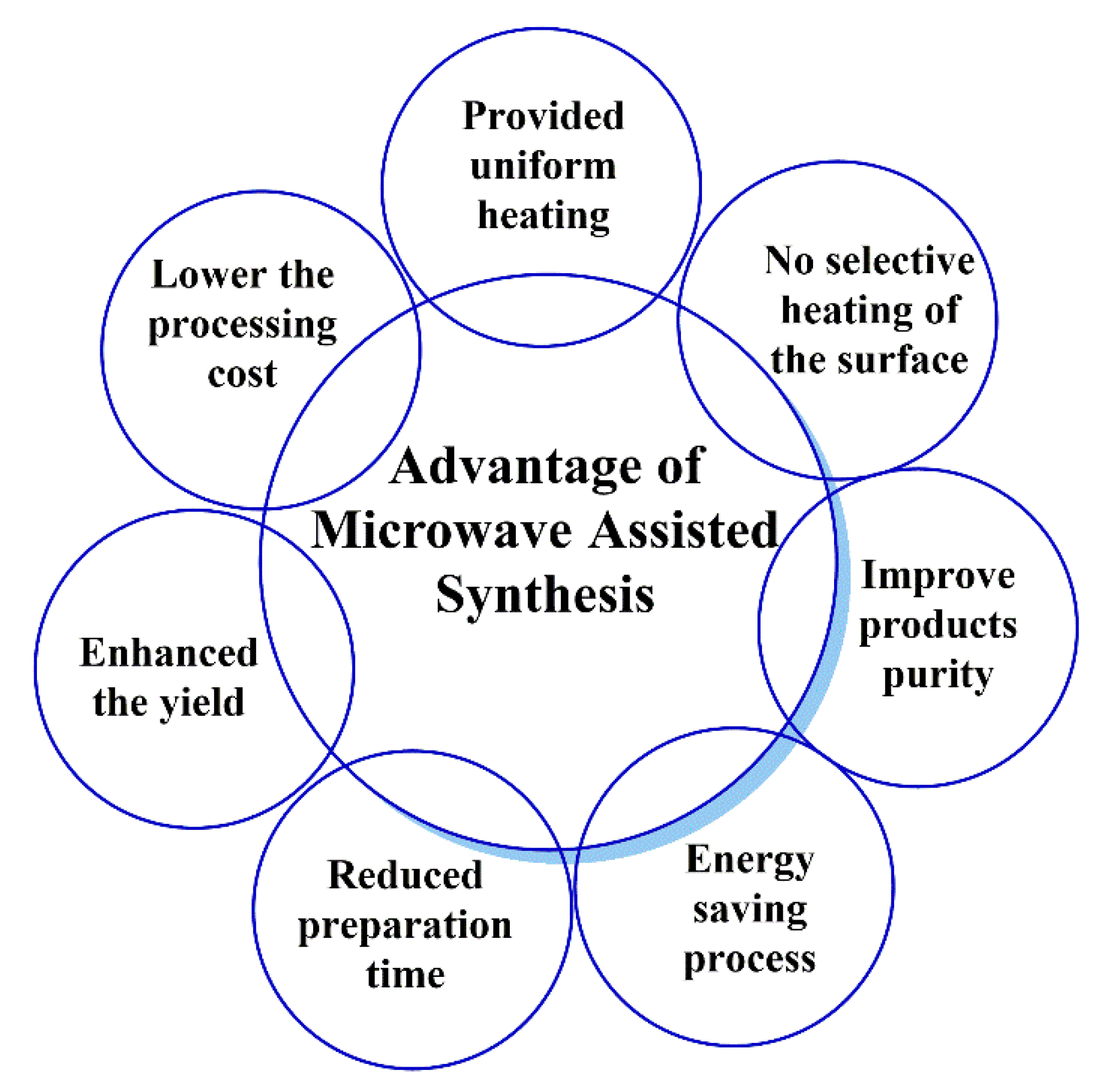
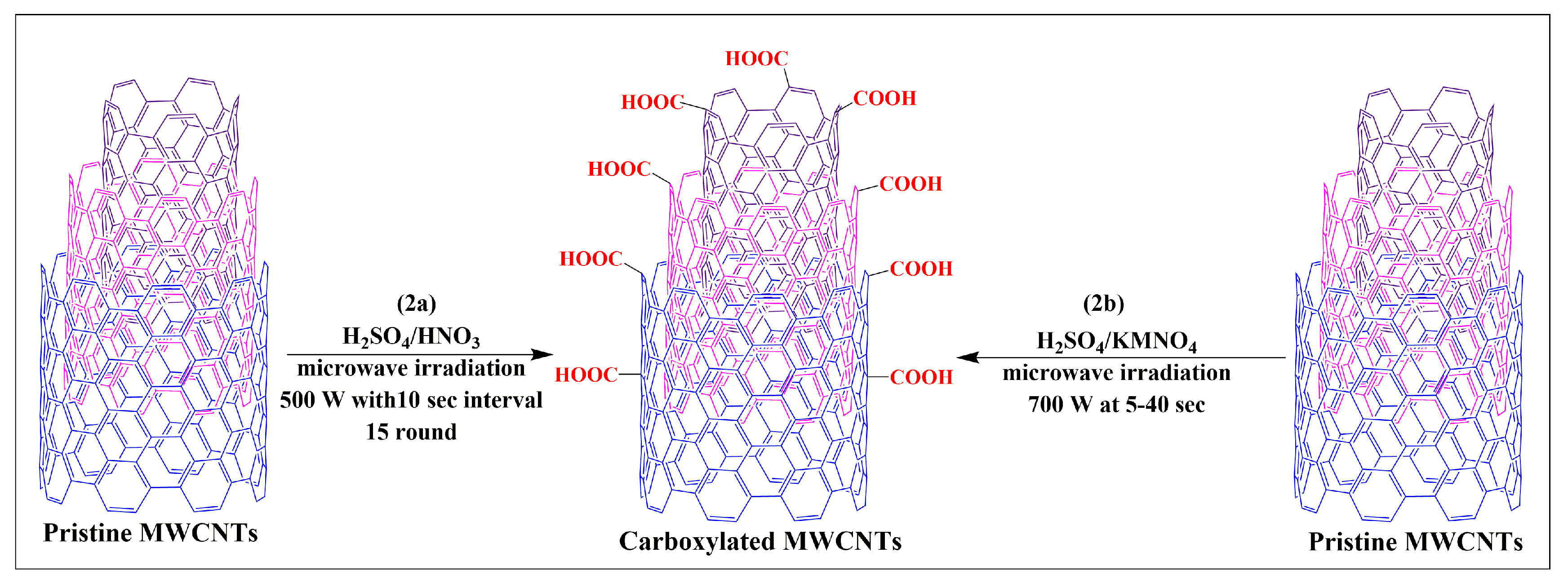
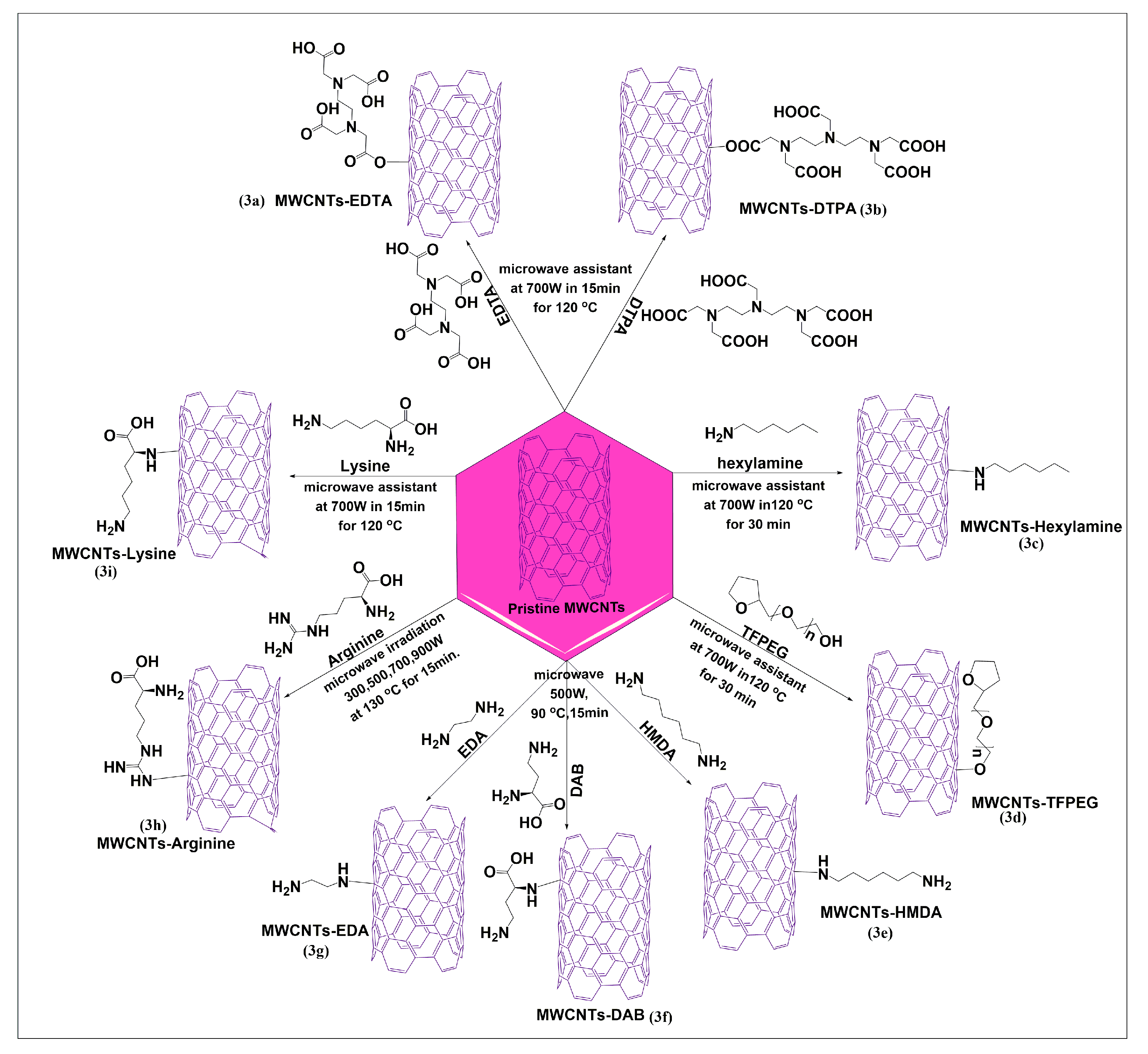
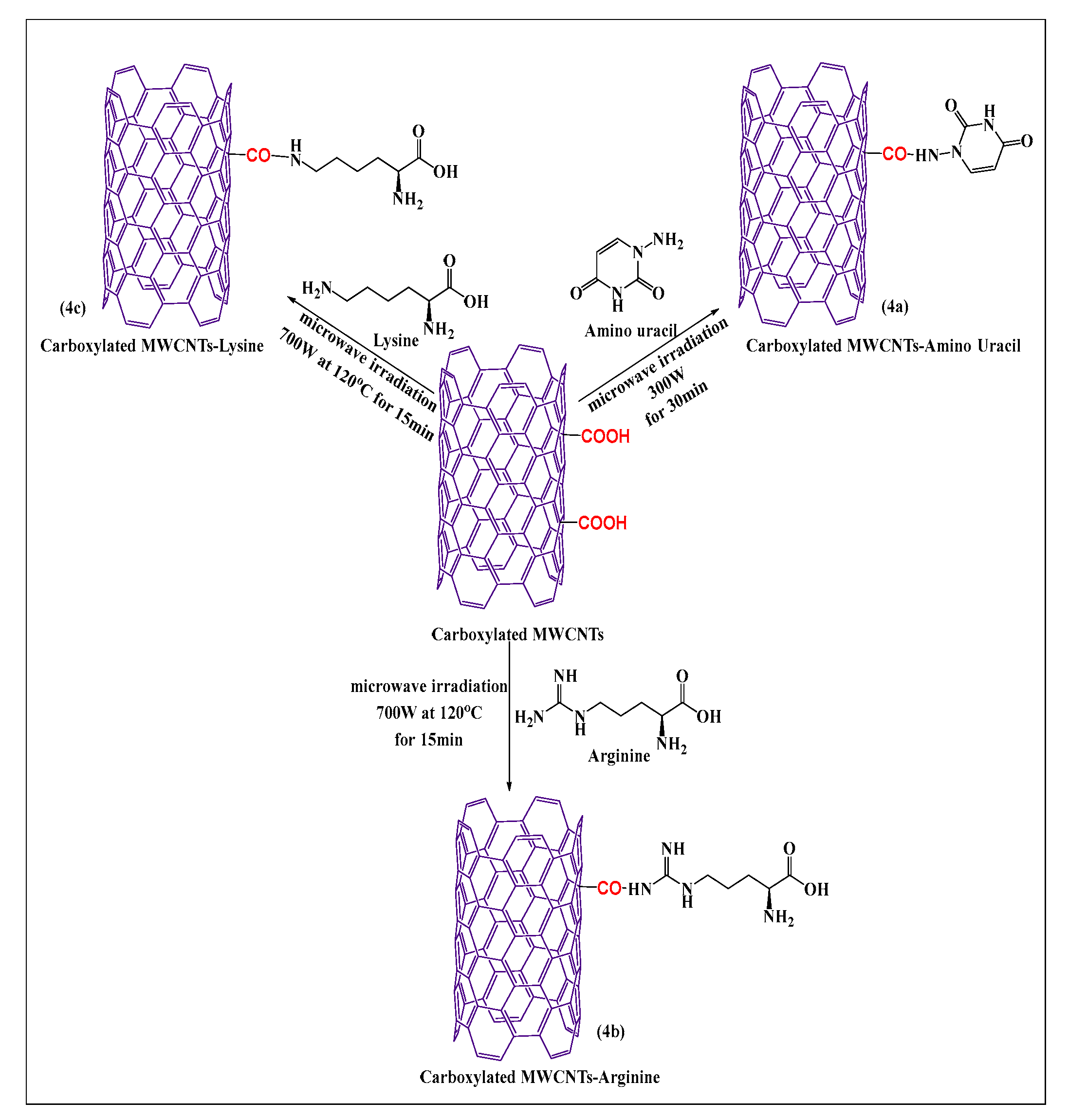

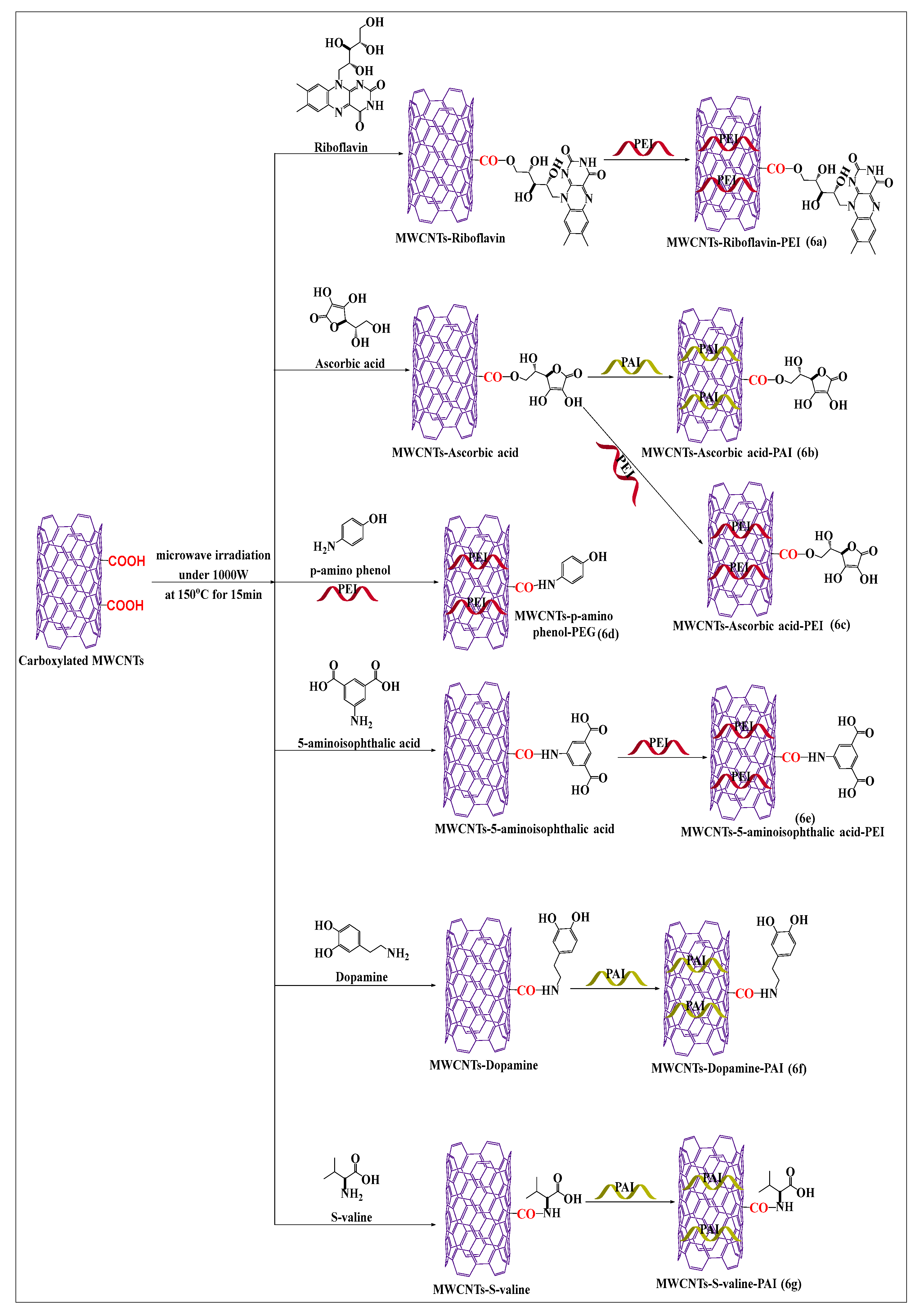
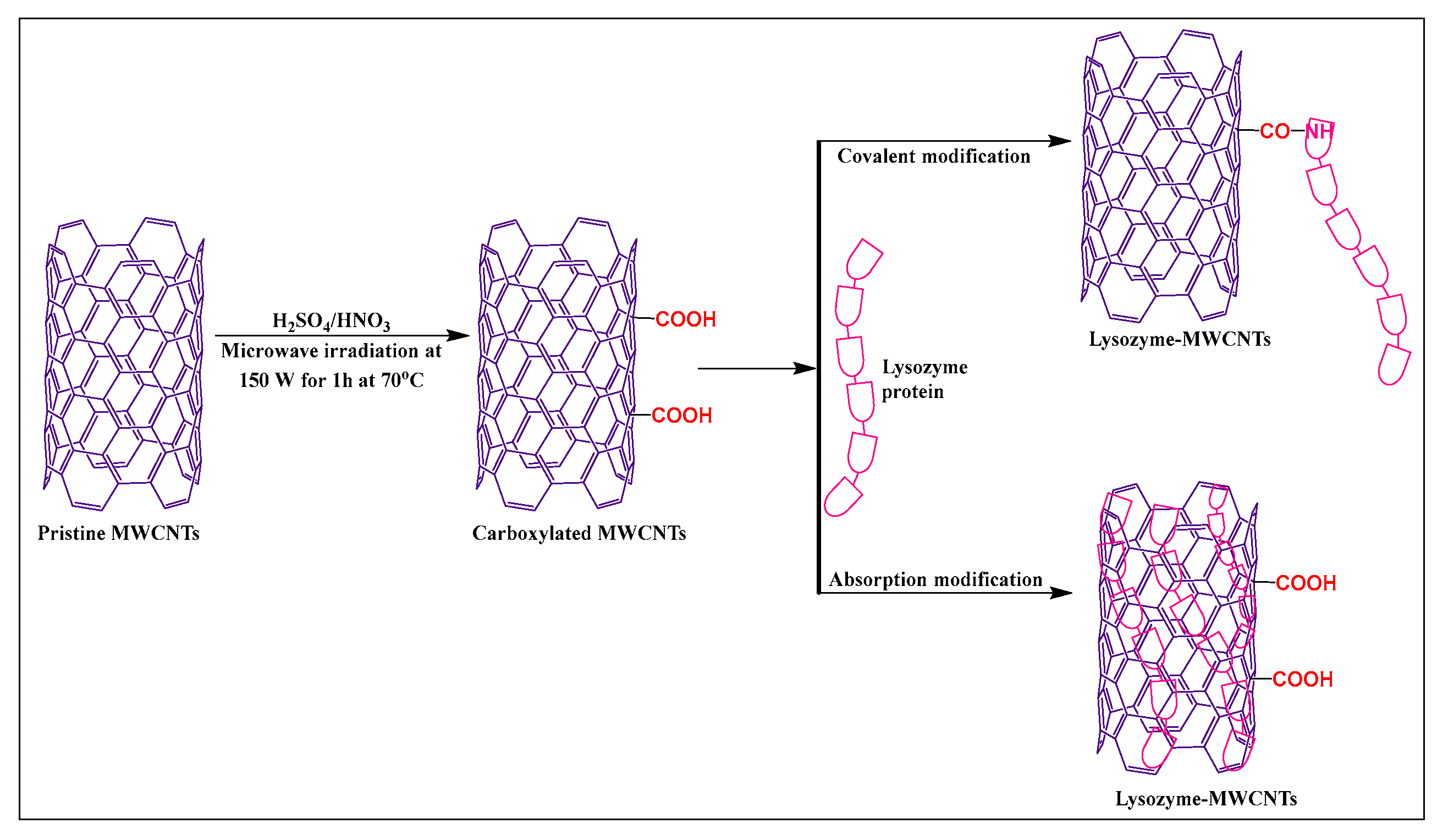
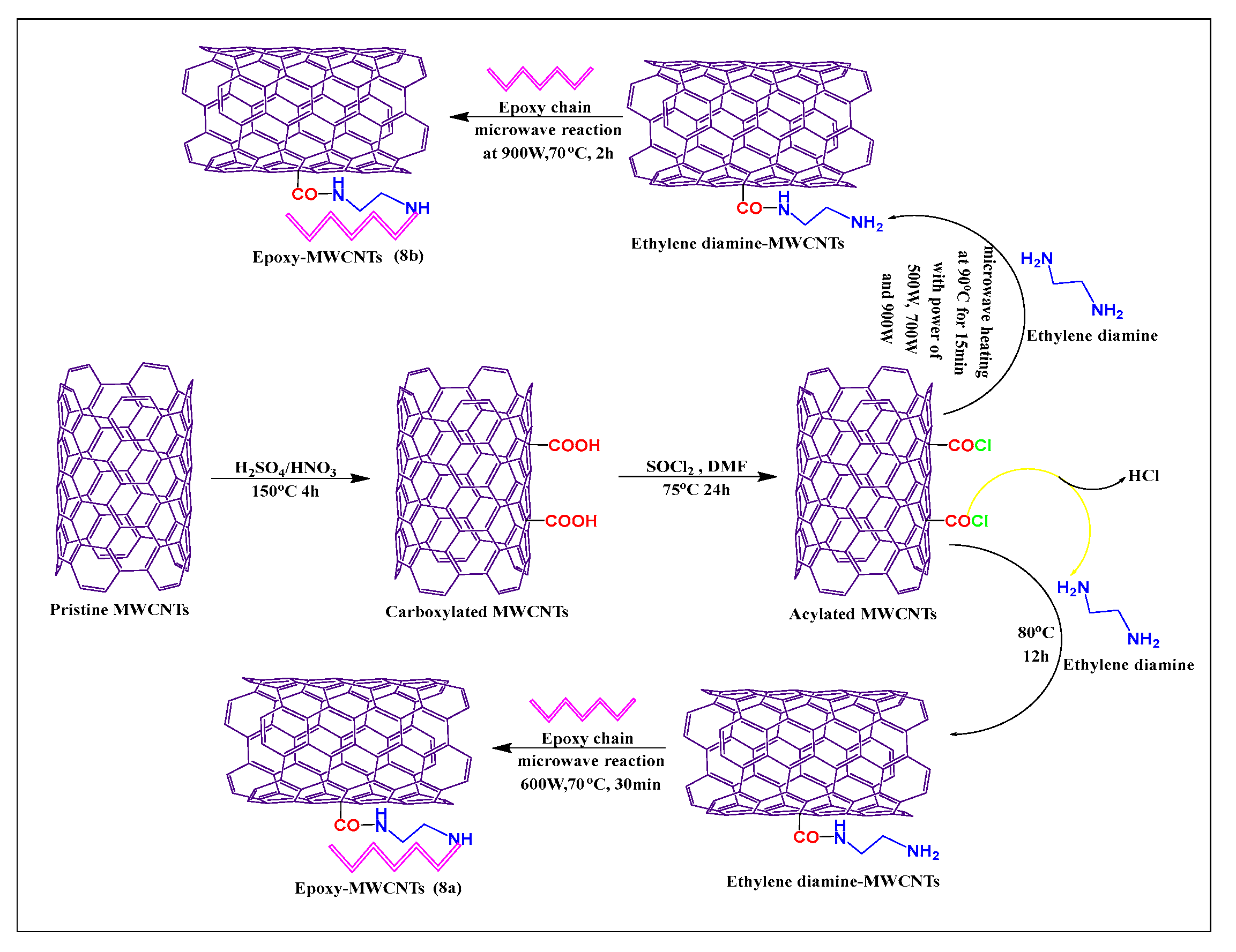
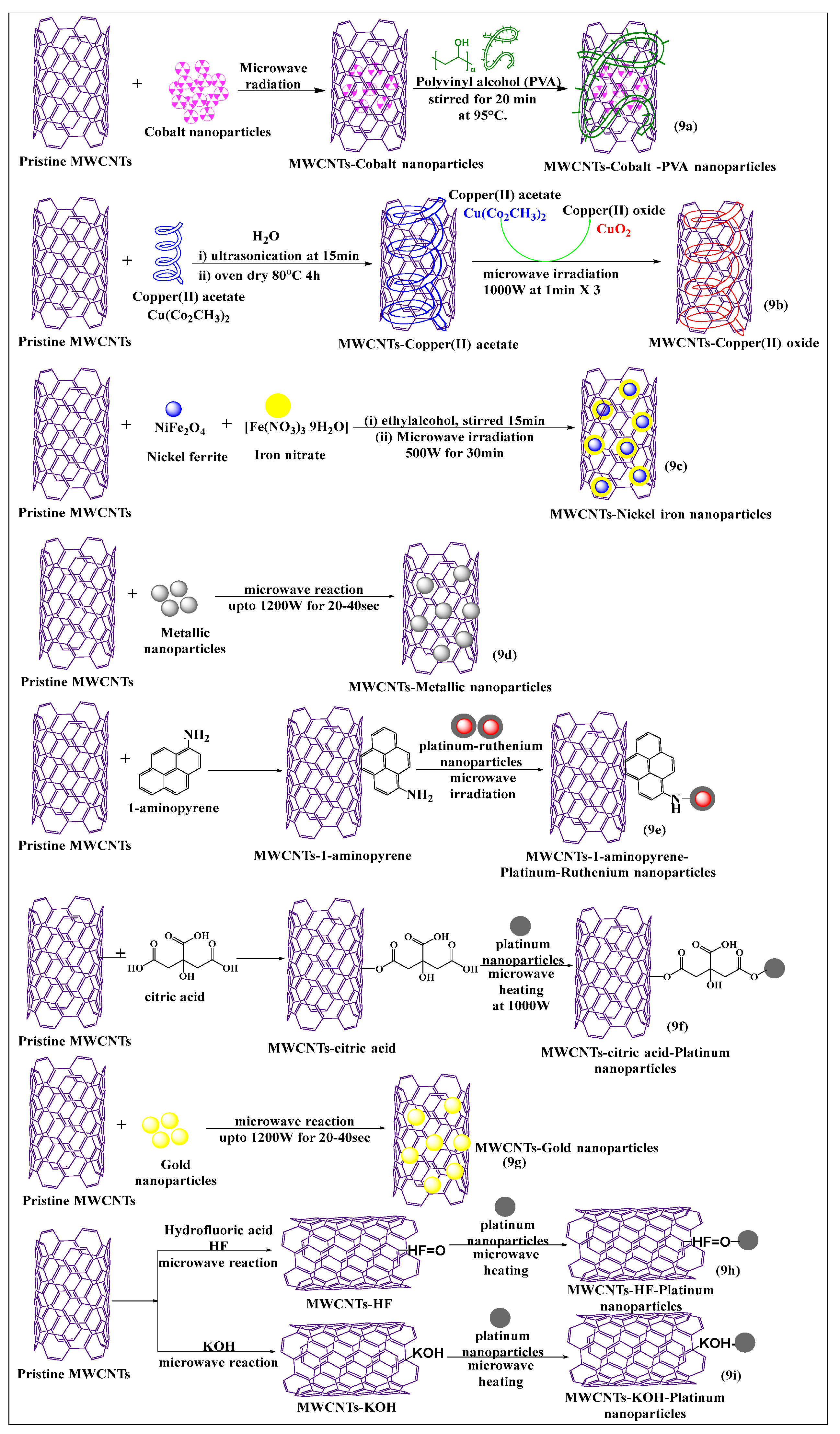

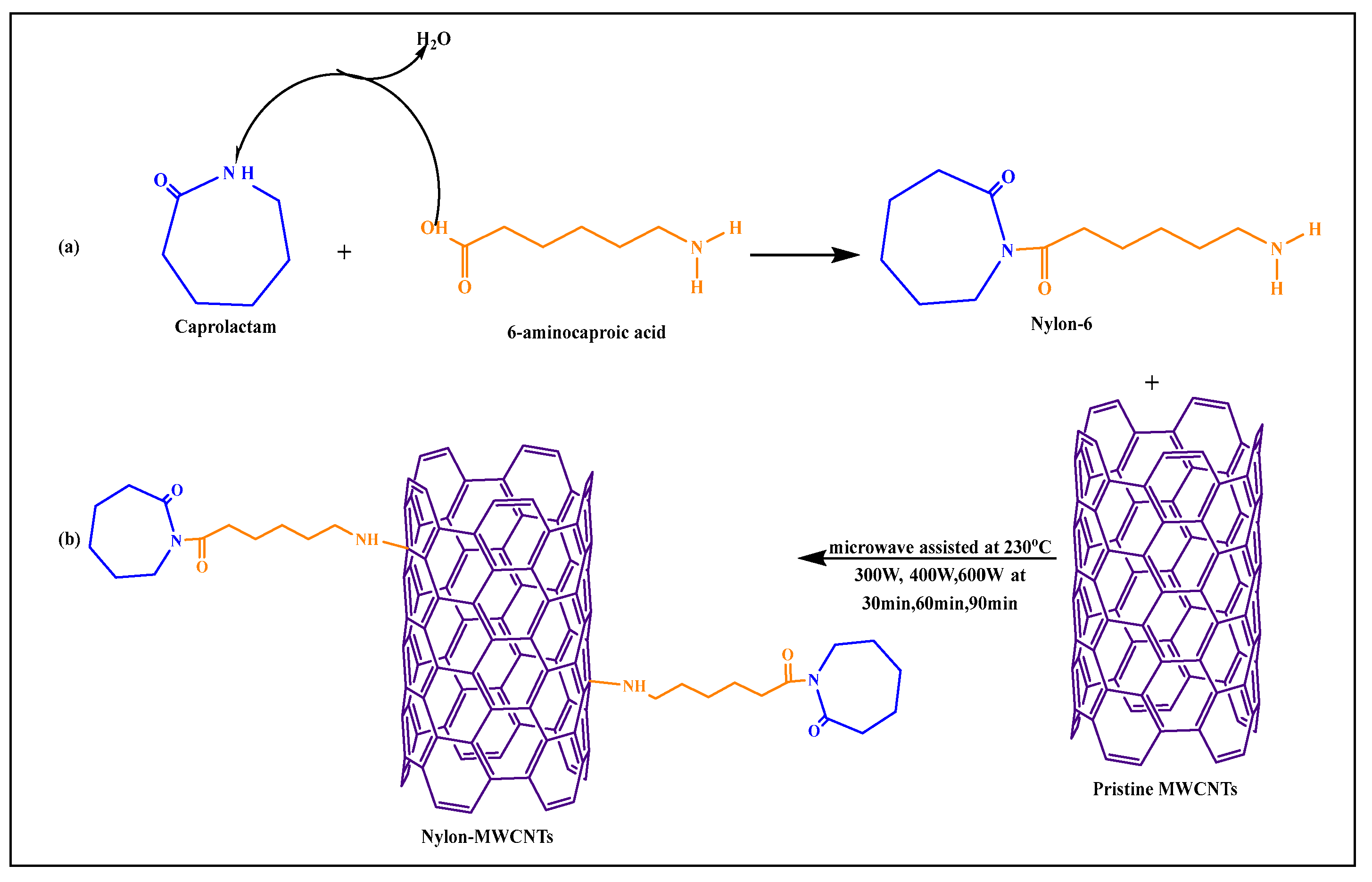
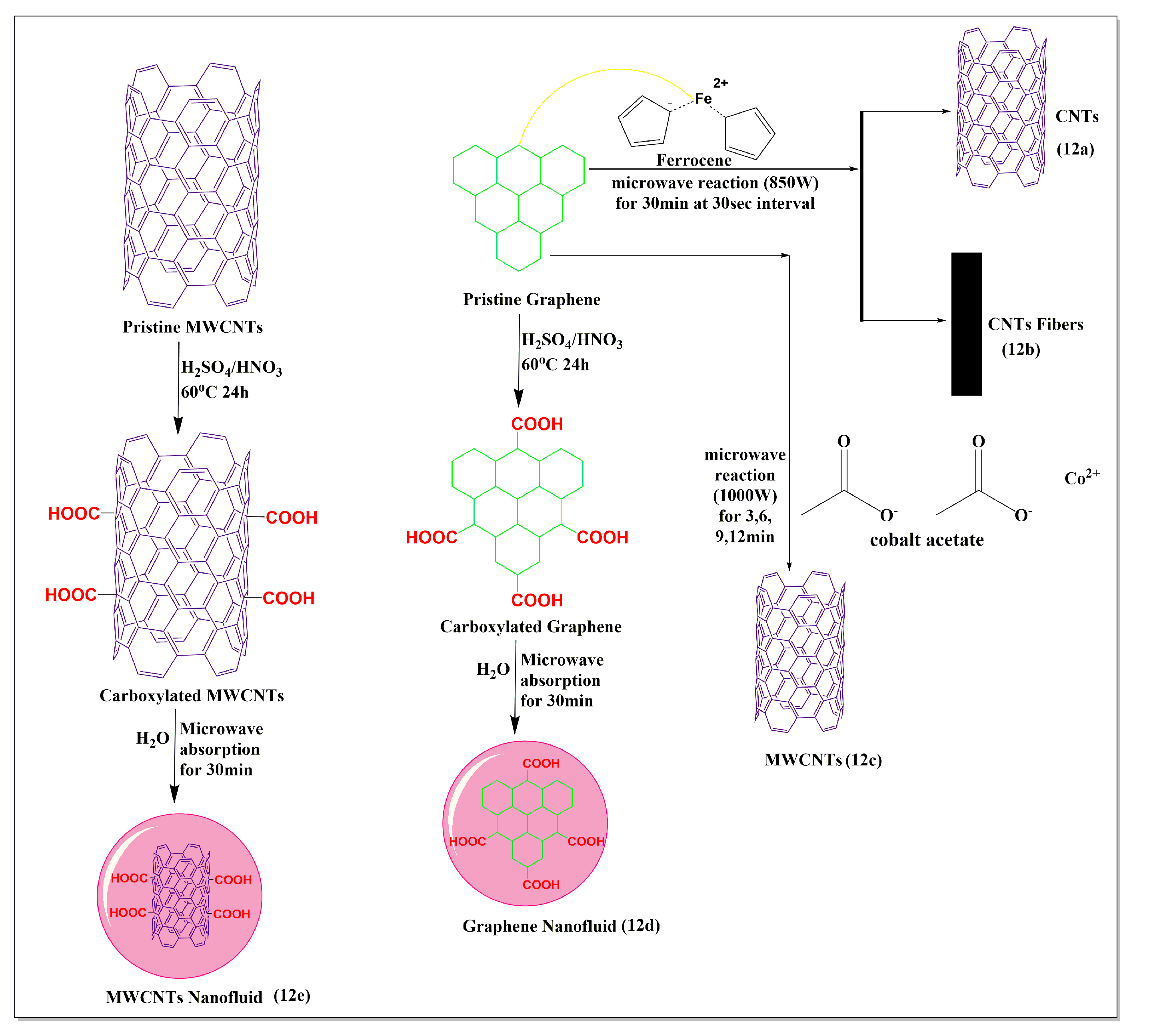

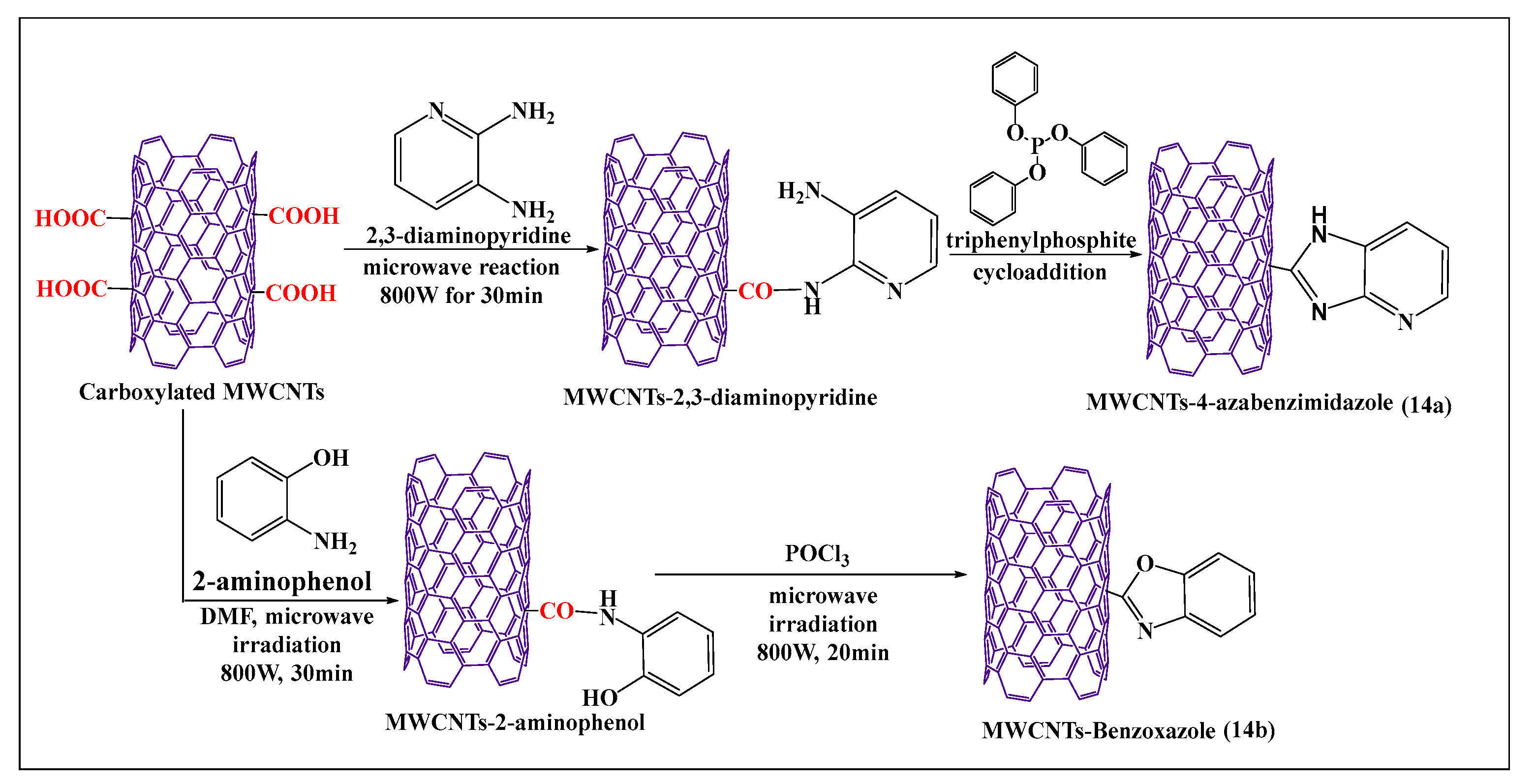
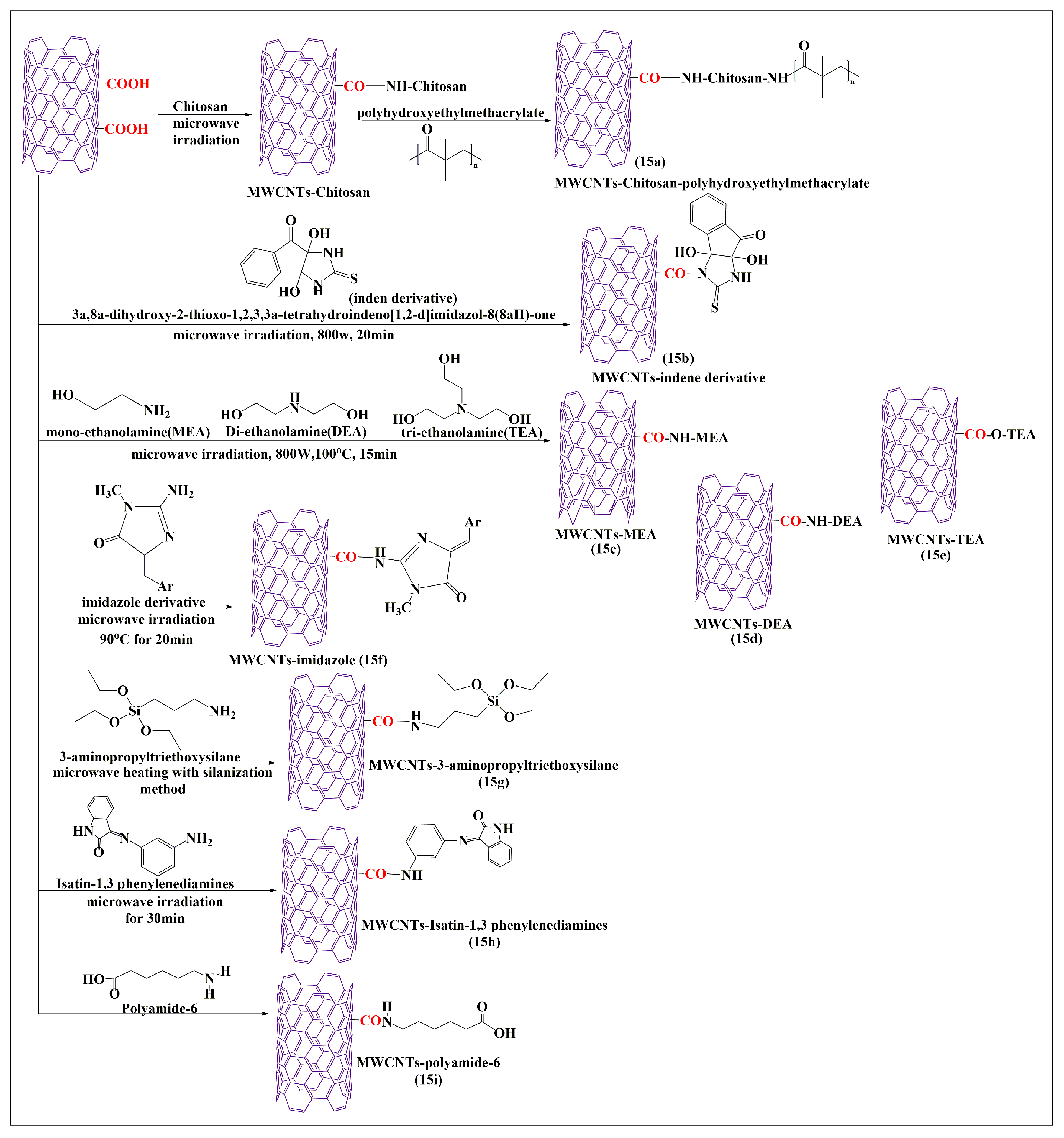
Disclaimer/Publisher’s Note: The statements, opinions and data contained in all publications are solely those of the individual author(s) and contributor(s) and not of MDPI and/or the editor(s). MDPI and/or the editor(s) disclaim responsibility for any injury to people or property resulting from any ideas, methods, instructions or products referred to in the content. |
© 2023 by the authors. Licensee MDPI, Basel, Switzerland. This article is an open access article distributed under the terms and conditions of the Creative Commons Attribution (CC BY) license (https://creativecommons.org/licenses/by/4.0/).
Share and Cite
Thakur, C.K.; Karthikeyan, C.; Abou-Dahech, M.S.; Altabakha, M.M.A.M.; Al Shahwan, M.J.S.; Ashby, C.R., Jr.; Tiwari, A.K.; Babu, R.J.; Moorthy, N.S.H.N. Microwave-Assisted Functionalization of Multi-Walled Carbon Nanotubes for Biosensor and Drug Delivery Applications. Pharmaceutics 2023, 15, 335. https://doi.org/10.3390/pharmaceutics15020335
Thakur CK, Karthikeyan C, Abou-Dahech MS, Altabakha MMAM, Al Shahwan MJS, Ashby CR Jr., Tiwari AK, Babu RJ, Moorthy NSHN. Microwave-Assisted Functionalization of Multi-Walled Carbon Nanotubes for Biosensor and Drug Delivery Applications. Pharmaceutics. 2023; 15(2):335. https://doi.org/10.3390/pharmaceutics15020335
Chicago/Turabian StyleThakur, Chanchal Kiran, Chandrabose Karthikeyan, Mariam Sami Abou-Dahech, Moawia Mohd A. M. Altabakha, Moayad Jamal Saeed Al Shahwan, Charles R. Ashby, Jr., Amit K. Tiwari, R. Jayachandra Babu, and Narayana Subbiah Hari Narayana Moorthy. 2023. "Microwave-Assisted Functionalization of Multi-Walled Carbon Nanotubes for Biosensor and Drug Delivery Applications" Pharmaceutics 15, no. 2: 335. https://doi.org/10.3390/pharmaceutics15020335
APA StyleThakur, C. K., Karthikeyan, C., Abou-Dahech, M. S., Altabakha, M. M. A. M., Al Shahwan, M. J. S., Ashby, C. R., Jr., Tiwari, A. K., Babu, R. J., & Moorthy, N. S. H. N. (2023). Microwave-Assisted Functionalization of Multi-Walled Carbon Nanotubes for Biosensor and Drug Delivery Applications. Pharmaceutics, 15(2), 335. https://doi.org/10.3390/pharmaceutics15020335







